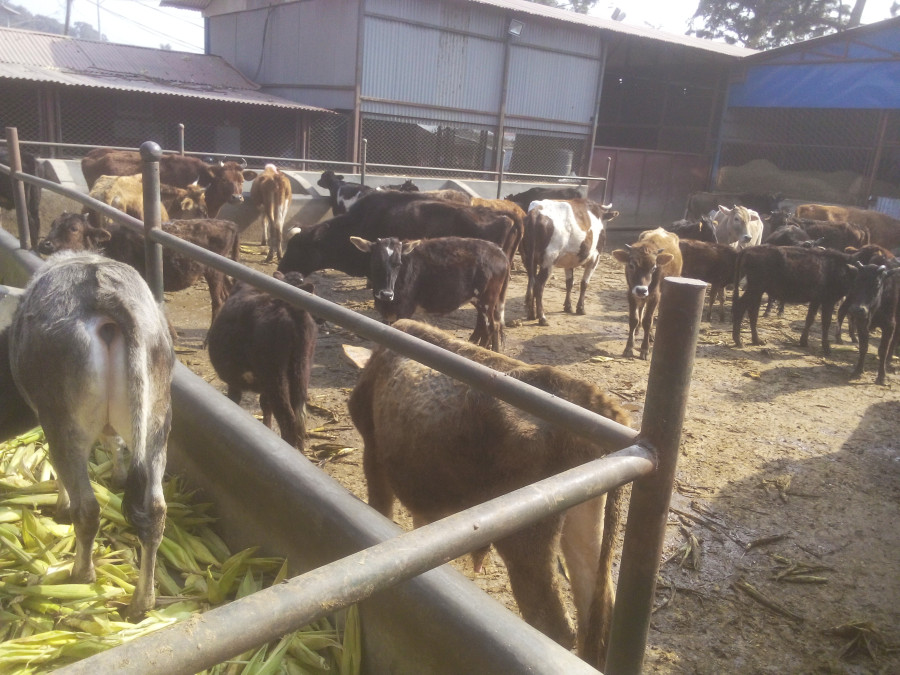Valley
While KMC fails, a person’s drive to manage strays thrives
There is almost no Kathmandu street that does not have a stray cow, either wandering along the road or sitting in a corner, on a heap of garbage, chewing on anything it thinks edible.
Anup Ojha
There is almost no Kathmandu street that does not have a stray cow, either wandering along the road or sitting in a corner, on a heap of garbage, chewing on anything it thinks edible.
For years, the Kathmandu Metropolitan City has launched various campaigns and drives to manage the number of cattle on the roads, but to no avail. The numbers have only increased over time. This increase in the number of abandoned cattle in the metropolis has been an issue of concern highlighted by many people for far too many times, however, authorities have till date failed to take proper action.
And what the KMC has failed to do, a small organisation, Math Mandir Gai Bacha Bachao Tatha Samaj Vikas Abhiyan, has been doing—efficiently too—for the past two years.
The shelter, formed by Gopal Neupane, in 2014, has helped find homes for 87 stray animals from around the metropolis and other municipalities from the Valley in the past year. Currently, the Abhiyan provides protection to 124 abandoned cattle in Bankali inside the premises of Pashupatinath temple. The eight ropanis of land in Bankali was turned into the shelter house after taking permission from the Pashupati Area Development Trust.
The organisation has also relocated an additional 70 cattle in two different barns in Kavrepalanchok. “I’m working to expand more barns in the area,” said Neupane. Ram Krishna Shrestha, ward-9 chairperson, said Neupane has taken up a task that the metropolis should have done much earlier. “This is praiseworthy,” said Shrestha.
Before establishing the shelter house five years ago, Neupane used to rescue sick stray animals and treat them.
Neupane’s organisation currently has 700 members and runs from the donations it collects from its members. “We need to spend at least Rs25,000 a day for the food and treatment of these animals, and it’s very difficult
for us to manage the funds,” said Neupane.
He said animals in the shelter need regular health check-ups because most of the animals have been largely eating poisonous food and toxic water.
“I am giving shelter to these helpless animals because these animals also have a right to live,” said Neupane. Talking to the Post he said, he can clear all the streets of animals within three years if the metropolis and municipalities coordinate with him. “I even went to meet Mayor Bidya Sundar Shakya and Chief Executive of the metropolis twice and submitted my proposal. They were very positive about the idea,” said Neupane. “But later I came to know that my proposal was ‘missing’.”
The KMC has launched various initiatives to tackle the issue. Last February, the metropolis had resumed a drive to capture stray animals from the metropolis. However, as per KMC, the drive could not become effective, as the metropolis could not give proper shelter to the animals taken from the street. “The metropolis didn’t have good Kanji houses (animal care houses). Many of the saved stray animals died in Teku last year, as they were already sick,” said Bishnu Prasad Joshi, former Chief of City Police. “Nobody came for the auction as well.” As a temporary solution, Joshi said the metropolis even let loose some stray animals outside of the valley. “We had no other solution,” he said.
The metropolis data shows that annually over 500 stray animals are released on the streets of Kathmandu. Owners release male calves, along with old and sick cows that stop giving milk. These abandoned animals cause
traffic congestion. In a bid to solve this traffic problem, the Metropolitan Traffic Police Division announced that it would search for the owners of the abandoned cattle and fine them Rs200. The division, however, could not book even a single owner.
When the Post contacted the newly appointed City Police Chief Dhanapati Sapkota about coordinating with
shelter homes to control the number of stray animals on the roads, he said that the metropolis would look into it if the proposal can give a long-term solution.




 8.12°C Kathmandu
8.12°C Kathmandu.jpg)









%20(1).jpg&w=300&height=200)

